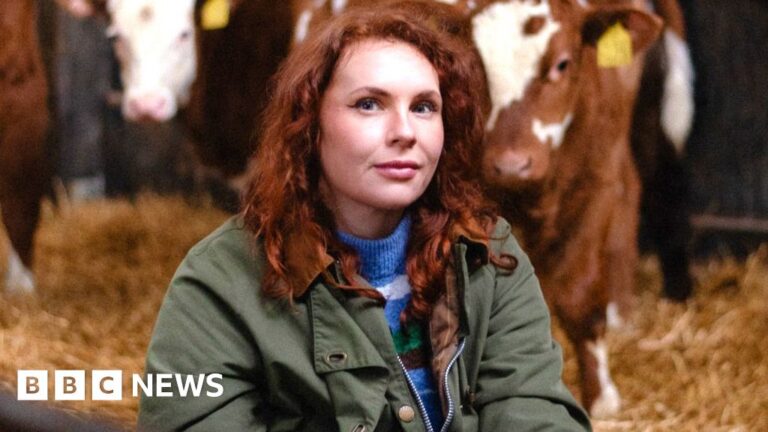- author, Russell Newlove
- role, BBC News
The task was simple: create a work of art whilst watching the election results. The completed work would go into the Parliamentary Art Collection and the artist would be paid £20,000. There were only two rules: it had to be politically balanced and reflect the geography of the UK as a whole.
For Joan Coates, official 2024 election artist, it’s an opportunity to “tell the story of the election alongside what we see in the media,” she says.
In the lead up to Election Day on July 4th, she plans to travel around the country with politicians and reporters to get a close look at their campaign activities.
While journalists may focus on the news of the day and quickly move on to the next topic, artists “can take a step back and look at things from a different perspective,” she says.
According to Coates’ website, her work explores themes that are often colored by political beliefs and ideologies, such as “the hidden histories and inequalities associated with rural and low-income areas” and “power, identity, wealth and poverty.” Will she struggle to remain politically balanced?
“It’s a difficult aspect but I think it’s similar to being from the countryside and going to the pub,” she told the BBC.
“In a country pub you get a lot of different people with all different backgrounds and political views. It’s a small place so you have to get along with everyone. So it’s something I’m used to in my everyday life.”
“I’m not here to pass judgement,” she says, “and although the work will always be interpreted in different ways by the audience, I think it’s important not to bring a political perspective to this role.”
“It’s a challenge, but it’s a really good challenge.”
Coates is the seventh official election artist, selected by the Speaker of the House’s Artwork Advisory Committee, tasked with creating artwork that “informs and inspires future generations.”
Previous artists include sculptor Cornelia Parker, photographer Simon Roberts and sketch artist Adam Dant.
Image source, Jonathan Yeo
The whole thing was “an amazing, crazy experience”, he tells me in his west London studio.
“Tony Blair had refused to have his portrait painted, or at least his advisers didn’t want him to do it.”
So the committee came up with the idea of focusing on portraiture, using an election painter.
“Elections are a bit like two sides going to war,” Yeo says. “There’s a long tradition of war artists documenting the war and then having election artists do the same job, but with the side job of painting portraits of the leaders of the three major parties.”
Finding enough time for a portrait of Blair was difficult: other party leaders William Hague and Charles Kennedy were keen, but Blair was kept at a distance, surrounded by advisers.
“I was usually surrounded on a battle bus with journalists, photographers and cartoonists,” Yeo said.
Eventually a plan was hatched: Yeo would wait in Blair’s office during his lunch break, and when he returned he would simply sit down to make the first sketches of the portrait.
“Blair came in, he was so charming, I made a few sketches, took a few photographs, and then about two minutes later Alistair Campbell came in and said, ‘Okay, your time’s up. Now…'” [go away]’.
The result was “proportional representation,” a stylish triptych of portraits of the leaders of the major parties, sized according to the proportion of the national vote they received.
“I put Blair in the middle, Hague on the right and Kennedy on the left. At the time, Blair was fairly centrist and in many ways the Liberal Democrat policies were more to the left than Labour policies.”
In 2005, he told the select committee that the scheme should continue.
“I think there’s a lot of potential to make this a tradition. I think there are a lot more stories we could tell about it.”
“It’s a moment when politicians engage with the public, and artists can interpret that dialogue in an interesting way.”
That engagement is perhaps most vividly expressed by the work Nicky Hirst made for the 2019 election.
Image source, British Parliament/Jessica Taylor
The dazzling mobile, which hangs from the roof of Portcullis House across from Parliament House, is made up of geometric shapes in bright primary colours, echoing the theme of her Instagram posts after that year’s election.
“I took public transport everywhere and spoke to people along the way,” she says.
“It became a trend for people to literally show their colors. People would put posters in their windows, put up signs outside. That sense of literally showing your colors moved me.”
“At the time, I was looking for signs.”
Symbols like the X on a ballot paper and the 10 for Downing Street appear repeatedly on electionartist2019’s feed, and ultimately, they served as inspiration for her final piece.
Image source, Nicky Hurst
Image source, Nicky Hurst
“It’s about celebrating the process, celebrating the right to have different opinions, to have conflict, to have doubts, and to work through that and carve your own path.”
It’s too early to say what form Joan Coates’ final work will take, but as a photographer, she says it will definitely have a photographic element to it.
“Looking at the submissions of past artists, it was really great to see the possibilities and diversity and that everything is accepted.”
The election is on the Fourth of July, but she has until September to present her work and, as she puts it, “look back and be glad.”
“There may be stories that we won’t even remember in six weeks’ time, so this piece of art reminds us of this moment in history in a different way.”

